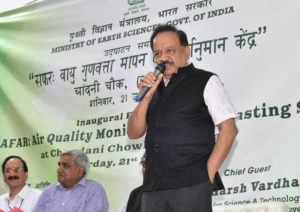
Union Science& Technology, Earth Sciences; Environment, Forest & Climate Change Minister Dr Harsh Vardhan on July 21. 2018 unveiled a state-of-the-art Air Quality and Weather Forecast System– SAFAR (System of Air Quality and Weather Forecasting)at Chandni Chowk in Delhi.
- The giant true colour LED display gives out real-time air quality index on 24×7 basis with colour coding alongwith 72-hour advance forecast.
- The system, first of its kind in the country, was developed indigenously in record time by Indian Institute of Tropical Meteorology, Pune and operationalized by India Meteorological Department (IMD).
- Based on the Air Quality Index on a particular day, Health advisory and related precaution will be notified to prepare citizens well in advance.
- In addition to monitoring and forecasting of regular air quality and weather parameters, the Chandni Chowk air quality station will also measure sun’s UV-Index and will provide measurement of online automatic ultrafine particles PM1 and Mercury, both of which have direct relevance to human health. Based on UVI, skin advisories will be issued on display.
- Mission model project SAFAR is implemented in four cities of India – Delhi, Pune, Mumbai and Ahmedabad as an operational service.
- As per the Union Minister, a preliminary economic assessment of the benefits of the system, if 5% of people suffering from air-pollution related diseases take advantage of the advisories and precautions in Delhi alone, it would result in a saving of nearly Rs. 2,500 crores in terms of health-related cost benefit.
- The system will be an integral part of India’s first Air Quality Early Warning System operational in Delhi and will strengthen the existing air quality network of SAFAR, Central Pollution Control Board and Delhi Pollution Control Committee.
- SAFAR will accelerate public awareness and preparedness of air pollution and weather extremes. It will also lead to better understanding of linkages among emissions, weather, pollution and climate. It will monitor all weather parameters like temperature, rainfall, humidity, wind speed and wind direction.
- In addition to regular air quality parameters like PM2.5, PM10, Sulfur Dioxide, Ozone, Nitrogen Oxides, Carbon Monoxide, the system will also monitor the existence of Benzene, Toluene and Xylene.
- Besides health, SAFAR system would benefit cost savings to several other sectors like agriculture, aviation, infrastructure, disaster management skill, tourism and many others, which directly or indirectly get affected by air quality and weather.


